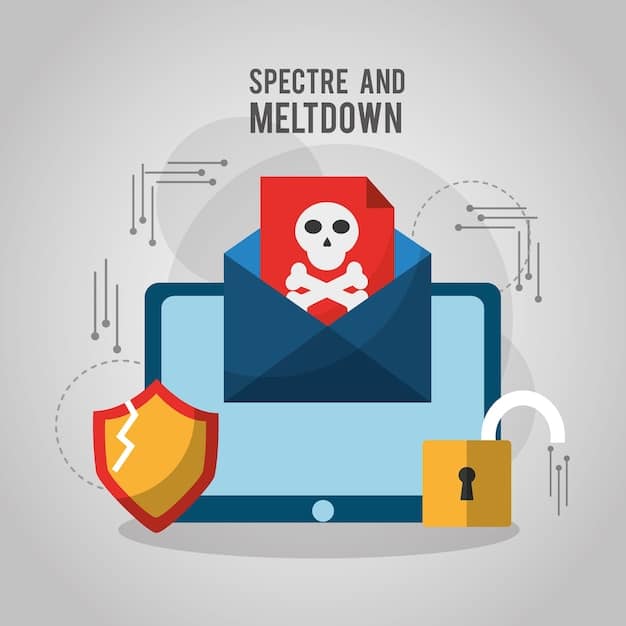The Dark Web Marketplace: Protecting Your Business from Illegal Activities

The Dark Web Marketplace presents a significant threat to businesses through illegal activities; monitoring and disruption strategies are essential for maintaining security and preventing data breaches.
The digital underworld, known as the Dark Web Marketplace, is a hotbed for illegal activities that can directly target and harm your business. Understanding these threats and implementing proactive monitoring and disruption strategies is crucial for safeguarding your assets and reputation.
Understanding the Dark Web Marketplace
The Dark Web Marketplace is not a single entity, but rather a collection of hidden websites and services accessible only through anonymizing networks like Tor. This anonymity makes it a haven for illegal activities, including the trading of stolen data, malware, and other illicit goods and services.
Businesses need to understand the specific risks the Dark Web poses to them. By focusing on a few core areas, your business can mitigate the threat coming from the Dark Web Marketplace.
What Makes the Dark Web Different?
Unlike the surface web that we access through standard search engines, the Dark Web operates on a different infrastructure. This decentralized nature makes it difficult to monitor and regulate, creating an environment where criminal activity can flourish.
Common Misconceptions About the Dark Web
Many people mistakenly believe that the Dark Web is exclusively used for illegal activities. While it is true that it hosts a significant amount of criminal activity, it is also used by journalists, activists, and others who need to protect their anonymity.
- Anonymity: Provides a high level of anonymity for users.
- Accessibility: Requires special software like Tor to access.
- Content: Hosts a wide range of content, both legal and illegal.

In conclusion, the Dark Web Marketplace is a multifaceted online environment that demands a nuanced understanding. Businesses aiming to protect their interests must grasp its characteristics and dispel common misconceptions to formulate effective security strategies.
The Types of Illegal Activities Targeting Businesses
The Dark Web is a bustling marketplace for a variety of illegal activities that can directly threaten businesses. Recognizing these activities is the first step in developing effective countermeasures to combat these various threats that may be present.
Businesses also need to understand how bad actors might be targeting them personally, since every business has different vulnerabilities. Use the following information as a launching point for securing your company.
Stolen Data and Credentials
One of the most common types of illegal activity on the Dark Web is the sale of stolen data and credentials. This includes usernames, passwords, credit card numbers, and other sensitive information that can be used to compromise business systems and accounts.
Malware and Ransomware
The Dark Web is also a source of malware and ransomware, which can be used to infect business networks and encrypt critical data. Attackers often use these tools to extort money from businesses in exchange for the decryption key.
- Data breaches: Sale of customer and employee data.
- Financial fraud: Use of stolen credit card information.
- Reputational damage: Exposure of sensitive business information.
Ultimately, the Dark Web serves as a hub for various nefarious activities that target businesses directly. By understanding the types of illegal goods and services traded, companies can better defend against potential threats and protect their assets and their customer data.
Why Businesses Are Vulnerable to Dark Web Threats
Many businesses are unintentionally vulnerable to Dark Web threats due to a combination of factors, including inadequate security measures, lack of awareness, and the ever-evolving nature of cyberattacks. Recognizing these vulnerabilities is essential for strengthening defenses and mitigating risks.
Businesses need to understand common vulnerabilities in order to avoid becoming complacent with their cybersecurity practices. The Dark Web is constantly evolving and improving. Cyber security must do the same.
Weak Security Measures
Businesses that lack strong security measures, such as up-to-date firewalls, intrusion detection systems, and robust password policies, are more vulnerable to cyberattacks. These weaknesses can be exploited by attackers to gain access to sensitive data and systems.
Lack of Employee Training
Many employees are not aware of the risks posed by phishing emails, malicious websites, and other social engineering tactics. This lack of awareness can make them easy targets for attackers who are trying to compromise their accounts or install malware on their devices.
Being complacent or ignorant can be very harmful to network security. Here are some important areas to learn about:
- Outdated security software: Using outdated software with known vulnerabilities.
- Insufficient monitoring: Failing to monitor network traffic for suspicious activity.
- Poor data encryption: Storing sensitive data without proper encryption.

In conclusion, several factors contribute to the vulnerability of businesses to Dark Web threats, but these reasons are not unassailable. By fixing loopholes and improving security practices, businesses can be much more safe from harm in the Dark Web Marketplace.
Monitoring Strategies for Dark Web Activities
Proactive monitoring of Dark Web activities can provide businesses with valuable intelligence about potential threats and vulnerabilities. This allows them to take preemptive action to protect their assets and prevent data breaches. There are monitoring strategies for businesses that can be very effective at locating threats and mitigating risks.
Monitoring also helps to give businesses peace of mind. It’s crucial to be proactive with monitoring because the amount of risk is constantly changing and difficult to predict.
Dark Web Monitoring Tools
There are a variety of Dark Web monitoring tools available that can scan Dark Web marketplaces, forums, and chat rooms for mentions of your business, its brands, or its employees. These tools can alert you to potential data breaches, stolen credentials, or other threats.
Human Intelligence Gathering
In addition to automated tools, human intelligence gathering can be valuable for monitoring Dark Web activities. This involves hiring security professionals or consultants who can infiltrate Dark Web communities and gather information about potential threats.
In the end, utilizing monitoring strategies is a very important part of securing a business. Here are some other aspects of monitoring:
- Threat intelligence feeds: Subscribing to threat intelligence feeds that provide information about emerging threats and vulnerabilities.
- Brand monitoring: Monitoring for mentions of your brand or products on the Dark Web.
- Employee monitoring: Monitoring for mentions of your employees’ credentials or personal information on the Dark Web.
In conclusion, monitoring strategies are really important to securing businesses from threats in the Dark Web Marketplace. Doing so helps to protect business assets as well as put the business and its employees minds at ease.
Disrupting Illegal Activities and Protecting Your Business
Beyond monitoring, businesses can take proactive steps to disrupt illegal activities on the Dark Web and protect their assets. This involves a combination of technical measures, legal actions, and collaboration with law enforcement agencies.
Taking proactive steps is of the utmost importance to stay ahead of those bad actors in the Dark Web Marketplace. Taking actions might mean having to invest more resources into prevention now to avoid problems later.
Taking Down Stolen Data
If you discover that your data has been stolen and is being sold on the Dark Web, you can take steps to have it removed. This may involve contacting the marketplace operator or working with law enforcement to shut down the listing.
Strengthening Your Security Posture
Investing in strong security measures is essential for preventing cyberattacks and protecting your data. This includes implementing firewalls, intrusion detection systems, multi-factor authentication, and other security controls.
- Reporting illegal activity: Reporting any illegal activity you discover on the Dark Web to law enforcement agencies.
- Working with law enforcement: Cooperating with law enforcement agencies to investigate and prosecute cybercriminals.
- Implementing a data breach response plan: Having a plan in place to respond to a data breach, including steps to contain the damage, notify affected parties, and restore systems.
In summary, disrupting illegal activities and protecting your business from Dark Web threats requires a multi-faceted approach. By combining proactive measures with defensive strategies, businesses can reduce their vulnerabilities and maintain data security.
Case Studies: Successful Dark Web Disruption
Real-world examples of successful Dark Web disruption can provide valuable insights and lessons for businesses looking to protect themselves. These case studies demonstrate the effectiveness of proactive monitoring, collaboration with law enforcement, and other disruption strategies.
Studying these cases can help businesses to formulate better plans of action. Use these cases to help secure your business and take necessary action to move forward.
Case Study 1: Takedown of a Major Dark Web Marketplace
In 2017, a coordinated effort by law enforcement agencies from several countries led to the takedown of AlphaBay, one of the largest Dark Web marketplaces at the time. This operation disrupted the sale of drugs, weapons, and other illegal goods and services, and resulted in the arrest of several individuals.
Case Study 2: Recovery of Stolen Customer Data
A major retail chain discovered that its customer data had been stolen and was being sold on the Dark Web. The company worked with law enforcement to identify the perpetrators and recover the stolen data. They also implemented stronger security measures to prevent future breaches.
Studying these cases can help businesses better understand the landscape of cybersecurity. Here are some other elements to consider:
- The importance of collaboration: The success of these operations highlights the importance of collaboration between businesses, law enforcement agencies, and other organizations.
- The value of intelligence sharing: Sharing threat intelligence can help businesses stay ahead of cybercriminals and prevent attacks.
- The need for continuous improvement: Businesses must continuously improve their security measures to keep pace with the ever-evolving threat landscape.
| Key Point | Brief Description |
|---|---|
| 🚨 Dark Web Threats | Illegal activities like data theft and malware distribution. |
| 🛡️ Monitoring Strategies | Using tools and human intelligence to detect potential threats. |
| 🚫 Disruption Tactics | Taking measures to remove stolen data and strengthen security. |
| 🤝 Collaboration | Working with law enforcement to combat cybercriminals. |
Frequently Asked Questions
▼
The Dark Web is a hidden part of the internet that requires special software like Tor to access, often used for anonymous and sometimes illegal activities.
▼
Your business’s data could be stolen and sold there, or it could be targeted by cybercriminals using malware found on the Dark Web.
▼
Use specialized Dark Web monitoring tools and services that scan for mentions of your company, its data, or compromised credentials.
▼
Immediately change compromised passwords, notify affected customers, and work with law enforcement to investigate the breach.
▼
Law enforcement agencies conduct investigations, arrest cybercriminals, and shut down illegal marketplaces, helping to disrupt criminal activities.
Conclusion
In conclusion, securing your business, you need to keep a close watch on the Dark Web Marketplace, take necessary precautions to fight off attacks, and create collaborative opportunities to ensure your protection in the long run.





